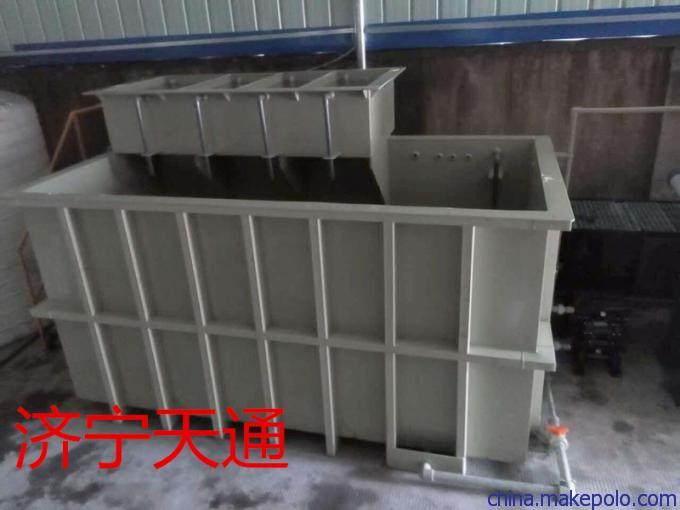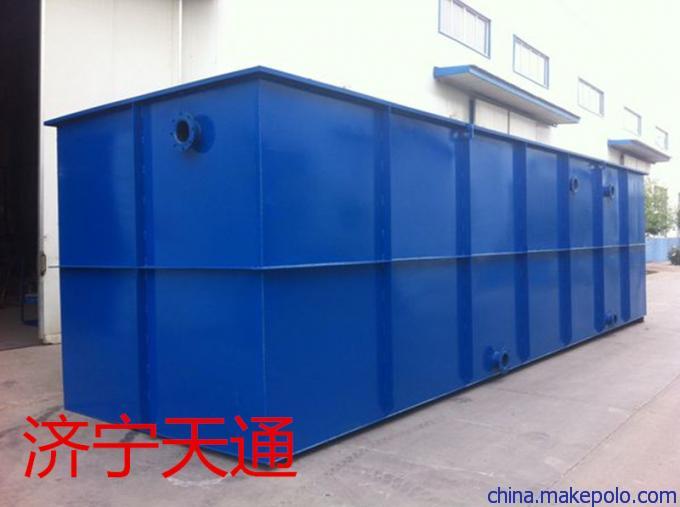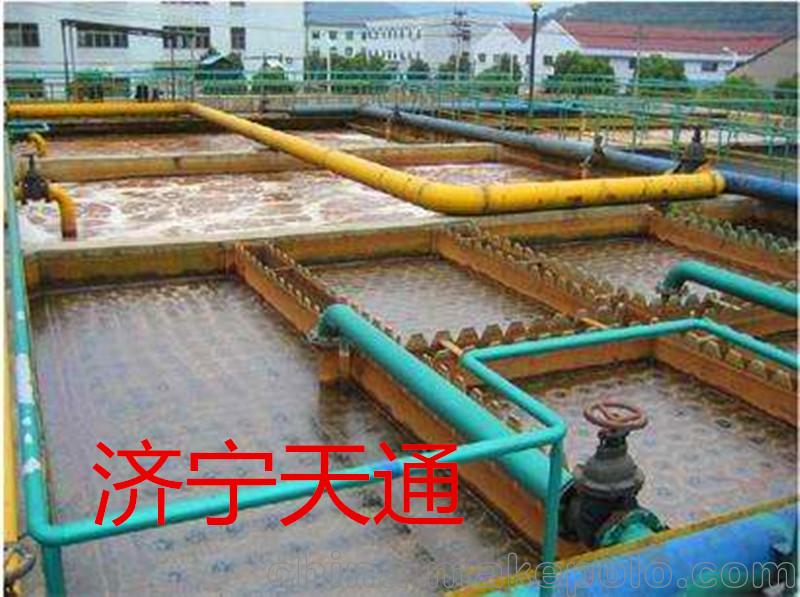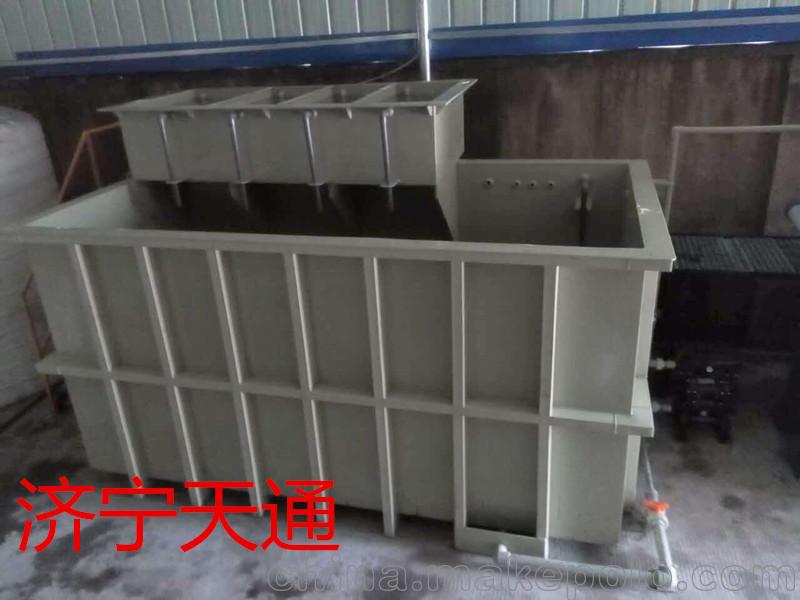
公司简介:济宁天通水处理设备有限公司水处理设备有限公司本着“科技兴企、人才兴企”经营理念和“质量为先、诚信为本”的企业宗旨,服务于社会,回报于社会,尽心尽力做好环保事业。公司主要经营环保型玻璃钢生物化粪池、地埋式玻璃钢消防蓄水池、隔油池、地埋式一体化中水处理设备、地埋式一体化雨水收集成套设备及各种工业废水处理设备。
纺织印染废水处理
纺织印染废水工业是一个用水量大、废水有机含量高,污染高的行业。
纺织印染废水主要来源于浆(织布)废水、精炼废水、漂白废水、丝光废水、染色废水、印花废水、整理废水等工序。废水水量大,含大量碱类,PH值高,水中还含有大量悬浮纤维屑粒、染料、助剂、浆料、整理剂等,因此色度大,有机物含量高,并含有重金属毒物来自铜、铅、锌、铬、汞、氰离子,若不经治理直接排放,将会对水体和环境造成严重的污染。对纺织印染废水的治理,首先也应该以防为主,积极改造生产工艺和设备,减少废物和废料的产生;通过逆流用水和重复用水来减少污染物的排放量,提高水的回用率;回用染化原料,降低生产成本,又减轻环境污染,一举多得,最终的废水再经处理排放。
纺织印染废水由于具有废水量大、水质复杂、水质水量变化大的特点,其治理比较复杂,它的处理一般也划分一级,二级,三级三个处理阶段。
一级处理多采用格栅、预沉池或初沉池,用简单的物理机械法或化学法使废水中悬浮物或块状体分离出来,或中和废水的酸碱度。
二级处理多是生物化学处理,可有效地去除胶状的溶解性有机污染物,有效地改善水质,废水可生化性较好时,可选择生化法;当废水可生化性较差时,可选择化学法,如混凝沉淀或加压气浮等方法。
三级处理多采用物理法或化学法,对其进行深度处理,达标排放或回用。
二、纺织印染废水中常用的处理法
1.物理法
(1)栅栏法:用于去除废水中纱头、布块等漂物和悬浮物。主要有格栅和格网、筛网等。
(2)调节池:由于纺织印染废水水质水量变化大,必须设调节池,一般当废水量5000t/d时,调节池停留时间为4h;废水量2000t/d时,调节池停留时间为5-6h;废水量小于1000t/d时,调节池停留时间为7-8h。
(3)沉淀池:印染废水的悬浮粒小,故不经其它(如化学)预处理时,不宜直接进行沉淀处理,沉淀池又分平流式、竖流式和辐流式,其中前者应用最多。
(4)过滤法:在印染废水中采用的过滤多是快滤池,即在重力作用下,水以6-12m/h的速度通过滤池完成过滤过程。
2.化学处理法
(1)中和法:在印染废水中,该法只能调节废水PH,不能去除废水中污染物,在用生物处理法时,应控制其进入生物处理设备前PH在6-9之间。
(2)混凝法:用化学药剂使废水中大量染料、洗涤剂等微粒子结合成大粒子去除,印染废水处理中需用的混凝剂有碱式氯化铝,聚丙烯酰胺、硫酸铝、明矾、三氯化铁等。
(3)气浮法:印染废水中含大量有机胶体微粒呈乳状的各种油脂等,这些杂质经混凝形成的絮体颗粒小、重量轻、沉淀性能差,可采用气浮法将其分离;目前在印染废水治理中,气浮法有取代沉淀法的趋势,是印染废水的一种主要处理方法。在印染废水中气浮处理主要采用加压溶气气浮法。
(4)电解法:该法脱色效果好,对直接染料、媒体染料、硫化染料、分散染料等印染废水,脱色率在90%以上,对酸性染料废水,脱色率在70%以上。该法缺点:电耗及电极材料耗量大,需直流电源,适宜于小量废水处理。
(5)吸附法:吸附法对印染废水的COD、BOB色去除十分有效,由于活性炭吸附投资较大,一般不优先考虑,近年来有泥煤、硅藻土、高岭土等活性多孔材料代替活性炭进行吸附的,对印染废水宜选用过滤孔发达的活性吸附材料。
(6)氧化脱色效率低,仅40-50%,混凝脱色效率较高,达50-90%之间,但用这些方法处理后,出水仍有较深的色度,必须进一步脱色处理,目前用于印染废水脱水的方法主要有光氧化、臭氧氧化和氯氧化法,由于价格等原因 ,应用最多的是氯氧化法,其常用的氧化剂有液氯、漂白粉和次氯酸钠,此种方法由于处理成本高和操作运行条件较高,而较少适应。
其中适宜用于印染废水治理的主要是兼氧生物塘。
(2)厌氧发酵法:纺织印染废水如单独采用好氧生化处理或附加混凝处理动力消耗大,且许多废水基质难以被分解和脱色,实践证明,辅以厌氧技术处理该类废水,效果良好,厌氧发酵工艺又分为常规厌氧发酵、高效厌氧发酵、厌氧接触法、厌氧过滤法、上流式厌氧污泥床(UASB)、改进型厌氧发酵装置(UASB+AF)、厌氧折流式工艺、厌氧流化床或膨胀床工艺、下流式厌氧过滤(固定膜)反应器等几种工艺。
(3)生物膜法:又分生物滤池、生物转盘、生物接触氧化法,其中后两种方法在国内的印染废水治理中使作较多,生物转盘法适用于小水量的印染废水处理,生物接触氧化处理印染废废水时多采用鼓风曝气接氧化法,生物滤池中塔式生物滤池也越来越多地应用到印染废水中。
(4)活性污泥法:氧化沟法也以其施工方便,日常运行费用低等优点应用于印染废水的治理。纺织印染废水由于其产品和生产工艺的不同,造成其水质的较大的差别。按其水质的差异程度,纺织印染工业废水可分为有明显特点的三个大类。
(一) 是洗毛废水
(二) 是化学纤维工业废水;
(三) 是纺织印染废水及水毛纺整废水。
麻纺、丝绸等工业废水、洗毛废水、化学纤维工业废水、棉纺织印染废水的治理方案下面都有较详细介绍,而毛纺织整废水和麻纺、丝绸等其它纺织印染废水由于其水质和污染程度与棉纺织印染废水相似,故棉纺织印染废水所采用的各种处理方法可同样用于处理,其它的纺织染色废水,只需根据毛纺织染色废水及麻纺、丝绸等废水的特点再适当地增加处理单元。如:应用电解法处理毛纺染整废水中的铬,使废水经处理后达到排放标准。
联系电话:18953768880
联系人:范经理
Company introduction: Jining water treatment equipment limited company of water treatment equipment limited company in line with "the science and technology, talent" business philosophy and the "quality first, integrity-based" business philosophy, service to society, return to society, do a good job of environmental protection. The company mainly focuses on environmental friendly fiberglass reinforced plastic septic tanks, buried glass fiber reinforced plastic fire storage tanks, oil separating ponds, buried integrated water treatment equipment, buried integrated rainwater collection equipment and various industrial wastewater treatment equipment.
Treatment of textile printing and dyeing wastewater
Textile printing and dyeing wastewater industry is an industry with high water consumption, high organic content and high pollution.
Textile printing and dyeing wastewater mainly comes from pulp (weaving) wastewater, refining wastewater, bleaching wastewater, mercerizing wastewater, dyeing wastewater, printing wastewater, finishing wastewater and other processes. Waste water, containing a large amount of alkali, high pH, water also contains a large number of suspended particles, lint dyes, additives, slurry, finishing agent, so the colority, high organic content, and contains toxic heavy metals from copper, lead, zinc, chromium, mercury, cyanide, without treatment directly emissions will cause serious pollution to the water body and the environment. Treatment of textile printing and dyeing wastewater, the first should be to prevent the main positive transformation of production technology and equipment, waste reduction and waste generation; to reduce emissions of pollutants by countercurrent water and reuse of water, improve water reuse; reuse of dyeing materials, reduce production cost, and reduce environmental pollution, too finally, the treated wastewater discharge.
Textile printing and dyeing wastewater is characterized by large quantity of waste water, complex water quality and large variation of water quality and quantity. Its treatment is rather complicated. Its treatment usually pides into three stages: first level, two level, three level.
The primary treatment is to use grille, presettler or primary sedimentation tank to separate suspended solids or lumps from waste water or neutralize the pH of wastewater by simple physical or chemical methods.
Two level processing is more biological chemical treatment can effectively remove the dissolved, colloidal organic pollutants, effectively improve the water quality, the biodegradability of the wastewater is better, can choose the biochemical method; when the wastewater with poor biodegradability, can choose the chemical method, such as coagulation precipitation or the pressurized air flotation method.
The three stage treatment adopts physical or chemical methods to deal with them deeply and discharge or reuse them.
Two, the commonly used treatment method in textile printing and dyeing wastewater
1. physical method
(1) the fence: it is used for removal of yarn or cloth bleaching and suspended substances. There are mainly grille, grid, screen and so on.
(2): due to changes in water quality regulation pool of textile printing and dyeing wastewater water, must be set when the waste water regulating pond, general 5000t/d, regulation pool residence time is 4H; the amount of wastewater 2000t/d, regulation pool residence time is 5-6h; the amount of waste water is less than 1000t/d, regulation pool residence time is 7-8h.
(3) sedimentation tank: the suspended particles of printing and dyeing wastewater are small. Therefore, it is not suitable for precipitation treatment without any other chemical pretreatment. The sedimentation tank is also pided into advection, vertical flow and radial flow. The former is the most widely used.
(4) filter method: the filter used in printing and dyeing wastewater is mostly fast filter, that is, under the action of gravity, the water is filtered through the filter at the speed of 6-12m/h.
2. chemical treatment
(1) neutralization method: in printing and dyeing waste water, this method can only regulate PH of wastewater and not remove pollutants from wastewater. When biological treatment is applied, PH should be controlled before entering biological treatment equipment, which is between 6-9.
(2) coagulation: chemical agents are used to remove large amounts of dyes and detergent particles into large particles. The coagulants needed for printing and dyeing wastewater treatment include basic aluminum chloride, polyacrylamide, aluminum sulfate, alum and ferric chloride.
(3) air flotation method: dyeing wastewater containing large amounts of organic colloidal particles with various oil emulsion, these impurities by flocs formed by coagulation with small, light weight, sedimentation performance is poor, can be used to separate the air flotation method; in treatment of printing and dyeing wastewater, air flotation method is to replace the precipitation trend. Is one of the main methods of dyeing wastewater treatment. In the process of printing and dyeing wastewater, the gas floatation of pressurized gas is mainly used.
(4) electrolysis: the decolorization effect is good, and the decolorization rate of direct dyes, media dyes, sulfur dyes, disperse dyes and other printing and dyeing wastewater is over 90%, and the decolorization rate of acid dye wastewater is over 70%. The disadvantages of the method are: the power consumption and the consumption of electrode materials are large, and the DC power supply is needed. It is suitable for the treatment of small amount of waste water.
(5) adsorption: the adsorption method of dyeing wastewater COD, BOB color removal is very effective, because of the larger adsorption of activated carbon investment, generally not preferred, in recent years, peat, diatomite and kaolin activated porous materials instead of activated carbon adsorption, printing and dyeing wastewater should active adsorption material selection filter Kong Fada.
(6) the oxidation decoloration efficiency is low, only 40 - 50%, decolorization efficiency is high, between 50 - 90%, but these treatments, the effluent still has deep color, must further decolorization methods currently used for printing and dyeing wastewater by dehydration of the main light oxidation, ozone oxidation and chlorine oxidation, because the price and other reasons, the application is the most commonly used chlorine oxidation, oxidation agent, chlorine bleaching powder and sodium hypochlorite, this method due to high processing cost and operating conditions is higher, and less adaptation.
Among them, it is the main oxygen biological pond which is suitable for the treatment of printing and dyeing wastewater.
(2) anaerobic fermentation process: textile printing and dyeing wastewater, such as aerobic production












